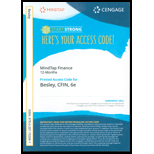
Concept explainers
Scenario Analysis is a technique used to identify the project’s risk and compare the bad and good circumstances with the base case scenario. It considers both the 1) sensitivity of the project’s
To carry out the scenario analysis, it is required to calculate the NPV of worst case, best case and base case, followed by the calculation of its standard deviation and co-efficient of variation. If the co-efficient of variation is higher than the average project of the company, the project should be rejected.
Expected NPV, Standard deviation of NPVs and co-efficient of variation of NPVs are calculated as below:
Here,
Probabilities of the occurrence is “
NPV for each probability is “
Standard deviation of NPVs is “
Co-efficient of Variation of NPVs is “
After conducting a scenario analysis, it is estimated, that the NPV of the project for all the three scenarios is as follows. Determine whether the project should be accepted or rejected if the maximum allowable co-efficient of variation is 0.7.
| Scenario | Probability | NPV |
| Best Case | 25% | $185,400 |
| Base Case | 60% | $128,300 |
| Worst Case | 15% | -$77,600 |
Want to see the full answer?
Check out a sample textbook solution
Chapter 10 Solutions
CFIN -STUDENT EDITION-ACCESS >CUSTOM<
- If data is not clear in image or image blurr then comment i will write values . No use chatgpt . I will give unhelpfularrow_forwarddon't use ai . if image is blurr then tell mearrow_forwardBrightwoodę Furniture provides the following financial data for a given enod: Sales Aount ($) Per Unit ($) 150,000 33 Less Variable E. - L96,000 13 Contribwaon Margin c 10 Less Fixed Expenses 35,000 et Income 25,000 a. What is the company's CM ratio? b. If quarterly sales increase by $5,200 and there is no change in fixed expenses, by how much would you expect quarterly net operating income to increase?arrow_forward
- Charlotte Metals' operating activities for the year are listed below: Beginning inventory $950,600 Ending inventory Purchases Sales revenue $420,700 $825,900 $1,601,850 Operating expenses $720.70 What is the cost of goods sold (COGS) for the year?arrow_forwardNo AIarrow_forwarddata is unclear then commentarrow_forward
- Solve plzarrow_forwardAnswer correctly otherwise unhelpfularrow_forwardYou've collected the following information from your favorite financial website. 52-Week Price Dividend Hi 77.40 Lo Stock (Dividend) Yield % PE Ratio Close Price Net Change 10.43 Acevedo .36 2.6 6 13.90 -.24 55.81 33.42 Georgette, Incorporated 1.54 3.8 10 40.43 -.01 131.04 70.05 YBM 2.55 2.9 10 89.08 3.07 50.24 35.00 13.95 Manta Energy .80 5.2 6 20.74 Winter Sports .32 1.5 28 15.43 ?? -.26 .18 According to analysts, the growth rate in dividends for YBM for the next five years is expected to be 21 percent. Suppose YBM meets this growth rate in dividends for the next five years and then the dividend growth rate falls to 5.75 percent, indefinitely. Assume investors require a return of 14 percent on YBM stock. According to the dividend growth model, what should the stock price be today? Note: Do not round intermediate calculations and round your answer to 2 decimal places, e.g., 32.16.)arrow_forward
- 1. Waterfront Inc. wishes to borrow on a short-term basis without reducing its current ratio below 1.25. At present its current assets and current liabilities are $1,600 and $1,000 respectively. How much can Waterfront Inc. borrow?arrow_forwardQuestion 3Footfall Manufacturing Ltd. reports the following financialinformation at the end of the current year:Net Sales $100,000Debtor’s turnover ratio (based onnet sales)2Inventory turnover ratio 1.25Fixed assets turnover ratio 0.8Debt to assets ratio 0.6Net profit margin 5%Gross profit margin 25%Return on investment 2%Use the given information to fill out the templates for incomestatement and balance sheet given below:Income Statement of Footfall Manufacturing Ltd. for the year endingDecember 31, 20XX(in $)Sales 100,000Cost of goodssoldGross profitOther expensesEarnings beforetaxTax @50%Earnings aftertaxBalance Sheet of Footfall Manufacturing Ltd. as at December 31, 20XX(in $)Liabilities Amount Assets AmountEquity Net fixed assetsLong termdebt50,000 InventoryShort termdebtDebtorsCashTOTAL TOTALarrow_forwardSolve correctly and no aiarrow_forward

 Financial Reporting, Financial Statement Analysis...FinanceISBN:9781285190907Author:James M. Wahlen, Stephen P. Baginski, Mark BradshawPublisher:Cengage Learning
Financial Reporting, Financial Statement Analysis...FinanceISBN:9781285190907Author:James M. Wahlen, Stephen P. Baginski, Mark BradshawPublisher:Cengage Learning

